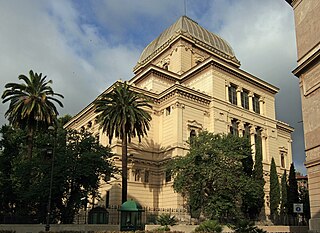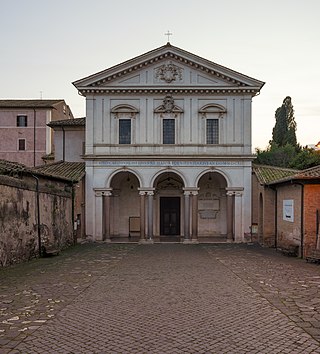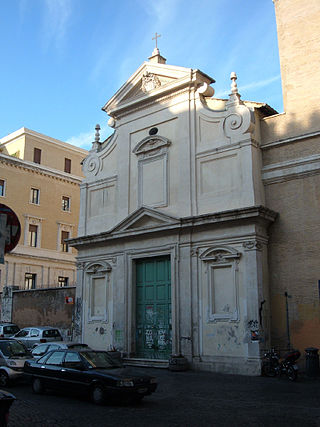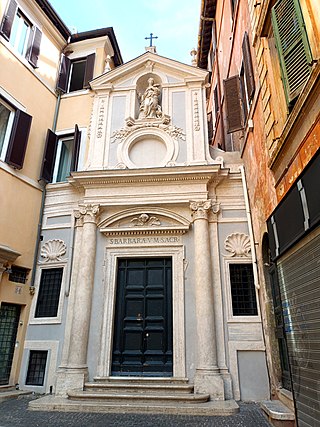
According to Catholic lore, Trophimus of Arles was the first bishop of Arles, in today's southern France.

Parione is the 6th rione of Rome, identified by the initials R. VI, and belongs to the Municipio I. Its name comes from the fact that in the area there was a huge ancient wall, maybe belonging to the stadium of Domitianus; the nickname people gave to this wall was Parietone, from which the name Parione.

Regola is the 7th rione of Rome, Italy, identified by the initials R. VII, and belongs to the Municipio I. The name comes from Arenula, which was the name of the soft sand that the river Tiber left after the floods, and that built strands on the left bank.

Sant'Angelo is the 11th rione of Rome, Italy, located in Municipio I. Often written as rione XI - Sant'Angelo, it has a coat of arms with an angel on a red background, holding a palm branch in its left hand. In another version, the angel holds a sword in its right hand and a scale in its left.

San Sebastiano fuori le mura, or San Sebastiano ad Catacumbas, is a minor basilica in Rome, Central Italy. Up to the Great Jubilee of 2000, San Sebastiano was one of the Seven Pilgrim Churches of Rome, and many pilgrims still favour the traditional list.

Santa Maria in Vallicella, also called Chiesa Nuova, is a church in Rome, Italy, which today faces onto the main thoroughfare of the Corso Vittorio Emanuele and the corner of Via della Chiesa Nuova. It is the principal church of the Oratorians, a religious congregation of secular priests, founded by St Philip Neri in 1561 at a time in the 16th century when the Counter Reformation saw the emergence of a number of new religious organisations such as the Society of Jesus (Jesuits), the Theatines and the Barnabites.

The Via Giulia is a street of historical and architectural importance in Rome, Italy, which runs along the left (east) bank of the Tiber from Piazza San Vincenzo Pallotti, near Ponte Sisto, to Piazza dell'Oro. It is about 1 kilometre long and connects the Regola and Ponte Rioni.

San Callisto is a Roman Catholic titular church in Rome, Italy, built over the site of Pope Callixtus I's martyrdom.
Giuseppe Sardi was an Italian architect active in Rome. He was born at Sant'Angelo in Vado, Marche which was then part of the Papal States. Known primarily for his church of Santa Maria del Rosario in Marino outside Rome, his name has been linked with the design of the façade of the church of Santa Maria Maddalena in Rome although his involvement with this and with some other building projects remains uncertain. He is not to be confused with the Swiss Italian architect, Giuseppe Sardi (1624–1699), who was active in Venice.

San Girolamo della Carità is a church in Rome, Italy, located near the Palazzo Farnese and Campo de' Fiori.

The Chiesa della Santissima Trinità dei Pellegrini is a Roman Catholic church located on Via dei Pettinari #36 In the rione of Regola of central Rome, Italy. It stands a block away from the Palazzo Spada on Via Capo di Ferro, while a few blocks away on the Via dei Pettinari stands the Ponte Sisto.

San Gregorio della Divina Pietà is a small Roman Catholic church facing the Piazza Gerusalemme located in Rione Sant'Angelo, in Rome, Italy. It is located near the Great Synagogue of Rome and the former Jewish quarter of Rome. It is sometimes referred to as San Gregorietto due to its small size. In the past, it was also called San Gregorio a Ponte Quattro Capi or Pons Judaeorum due to its proximity to the bridge known now as Pons Fabricius, connecting the sector to the Tiber island.

San Biagio della Pagnotta or San Biagio degli Armeni is a church in Rome, in the Ponte district, on via Giulia, near Palazzo Sacchetti. It is dedicated to Saint Blaise and is the national church of the Armenian community in Rome.

Via dei Coronari is a street in the historic center of Rome. The road, flanked by buildings mostly erected in the 15th and the 16th century, belongs entirely to the rione Ponte and is one of the most picturesque roads of the old city, having maintained the character of an Italian Renaissance street.

Santi Simone e Giuda is a deconsecrated Catholic church in the center of Rome, Italy. It is important for historical reasons.

Santa Barbara dei Librai is a small Roman Catholic church in Rome, Italy. It was once known as Santa Barbara alla Regola after the rione in which it was located. Today it now considered within the rione of Parione, near the Campo de' Fiori.

Piazza Farnese is the main square of the Regola district of Rome, Italy.

The Carceri Nuove was a prison built in the mid-17th century at the instigation of Pope Innocent X and his ideals of humanity and clemency. The New Jails were to replace other prisons throughout the city. This jail remained in operation until the construction of the judicial prison of Regina Coeli in Trastevere at the turn of the 20th century. The building, in 2020, housed the Direzione Nazionale Antimafia e Antiterrorismo.

The Collegio Ghislieri was a building in Rome, seat of the eponymous charitable institution, important for architectural and historical reasons.

Palazzo Sacchetti is a palazzo in Rome, important for historical and artistic reasons.






















